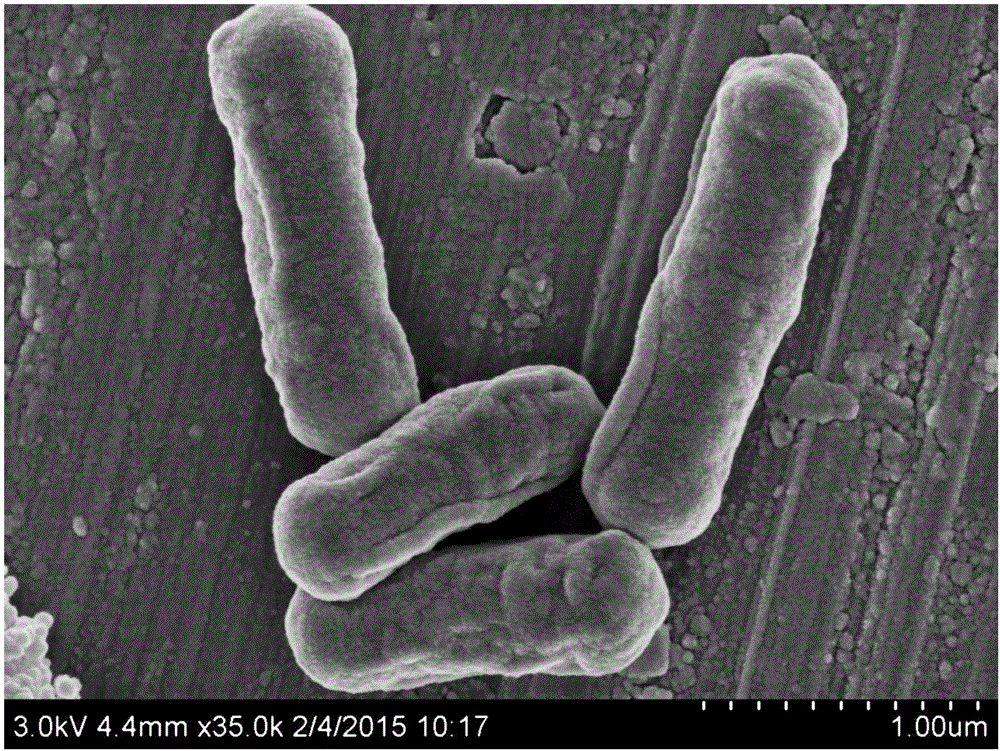Method for immobilized culture of salt-tolerant bacillus strains and application
A technology of immobilized cultivation of halotolerant bacillus, applied in chemical instruments and methods, methods based on microorganisms, biochemical equipment and methods, etc., to achieve the effect of not easy to lose, obvious effect, and remarkable effect
- Summary
- Abstract
- Description
- Claims
- Application Information
AI Technical Summary
Problems solved by technology
Method used
Image
Examples
Embodiment 1
[0034] 1.1. Screening of halotolerant bacillus strains:
[0035] (1) Get 15g of soil samples from sun-dried salt fields, and place them in 150ml of high-salt wastewater containing azo dyes, potassium dichromate, and phenol for anaerobic treatment for 8 days;
[0036] (2) Get 8ml of the waste water that above-mentioned anaerobic treatment has finished, inoculate in the 150ml high-salt waste water that contains azo dyestuff, potassium dichromate and phenol respectively in fresh configuration, anaerobic treatment again 8 days;
[0037] (3) Repeat step (2) 4 times; Get 80 μ l of waste water that has been treated for the last time and evenly spread it on the activated plate medium, and after 24 hours of growth, mark the single colony on the plate medium;
[0038] (4) Pick a single colony on the culture medium, inoculate it into the enrichment medium for aerobic growth for 24 hours, and then place all of them in 150ml of high-salt wastewater containing azo dyes for anaerobic treatme...
Embodiment 2
[0047] Embodiment 2: The halotolerant Bacillus bacillus loaded with magnetic nanoparticles cultivated in embodiment 1 is applied to the treatment of high-salt wastewater containing azo dyes. The specific process is as follows:
[0048] Put the halotolerant Bacillus strain loaded with magnetic nanoparticles with a concentration of 50-300mg / L into the synthetic wastewater with a salt concentration of 15% and a methyl red concentration of 500mg / L at a volume ratio of 1.5% for degradation Effect test, put the whole system in an anaerobic reactor, pass nitrogen into the anaerobic reactor for 5 minutes, seal it and place it in a low-speed shaker for shaking culture. Set the shaking speed at 50rpm, take appropriate amount of liquid after 1 hour, 2 hours and 6 hours of degradation, separate by magnetic field, centrifuge, and then take the supernatant to read at 420nm in the spectrophotometer. This embodiment is divided into five groups of parallel experiments, and the degradation temp...
Embodiment 3
[0051] Embodiment 3: the halotolerant bacillus bacillus that is loaded with magnetic nanoparticles cultivated in embodiment 1 is applied in the treatment of high-salt wastewater containing potassium dichromate, and the specific process is as follows:
[0052] Put the halotolerant Bacillus strain loaded with magnetic nanoparticles with a concentration of 50-300mg / L into the synthetic wastewater with a salt concentration of 15% and a potassium dichromate concentration of 150mg / L at a volume ratio of 1% for degradation Effect test, put the whole system in an anaerobic reactor, pass nitrogen gas into the anaerobic reactor for 5 minutes, seal it, place it in a low-speed shaker for shaking culture. Set the shaking speed at 50 rpm, take appropriate amount of liquid every 8 hours, undergo magnetic field separation, centrifuge, and then take the supernatant for analysis and measurement by atomic absorption spectrophotometer and chemical titration. This embodiment is divided into five g...
PUM
| Property | Measurement | Unit |
|---|---|---|
| particle diameter | aaaaa | aaaaa |
Abstract
Description
Claims
Application Information
 Login to View More
Login to View More - R&D
- Intellectual Property
- Life Sciences
- Materials
- Tech Scout
- Unparalleled Data Quality
- Higher Quality Content
- 60% Fewer Hallucinations
Browse by: Latest US Patents, China's latest patents, Technical Efficacy Thesaurus, Application Domain, Technology Topic, Popular Technical Reports.
© 2025 PatSnap. All rights reserved.Legal|Privacy policy|Modern Slavery Act Transparency Statement|Sitemap|About US| Contact US: help@patsnap.com


